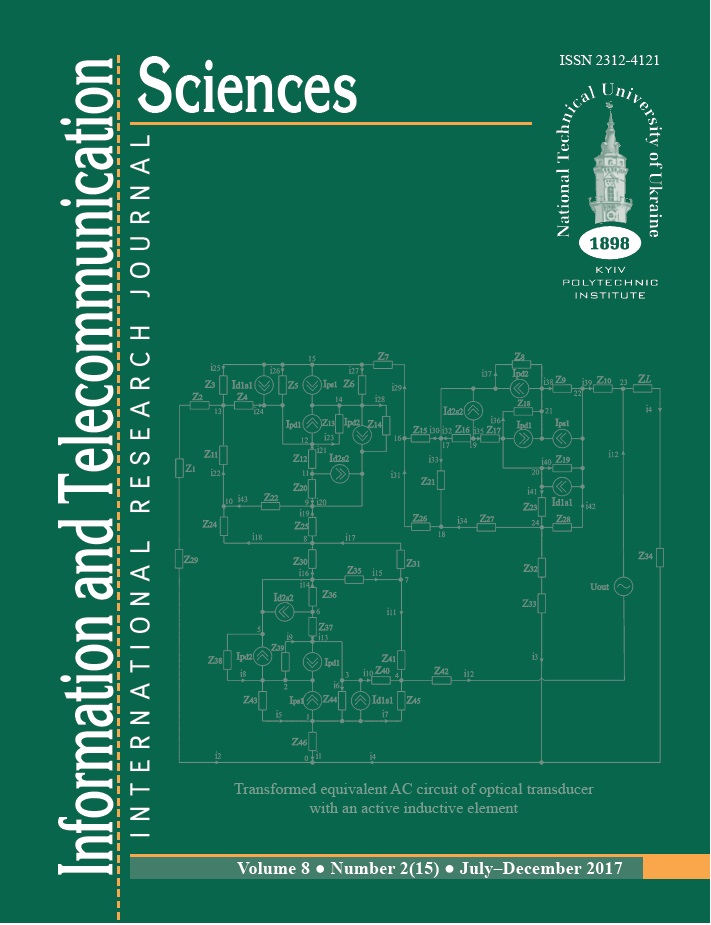CREATION OF PSEUDO-RANDOM SEQUENCES BASED ON CHAOS FOR FORMING OF WIDEBAND SIGNAL
DOI:
https://doi.org/10.20535/2411-2976.22017.5-10Keywords:
broadband signal, chaos, pseudorandom sequence, autocorrelation function, confidentiality of information transmission.Abstract
Background. Telecommunication systems with a broadband signal have improved noise immunity, the ability to receive a signal in multipath, as well as electromagnetic compatibility with neighboring radio electronic devices. The use of known pseudo-random sequences to create systems doesn’t ensure their high confidentiality due to the possibility of their selection when receiving a signal. A significant increase in the confidentiality of the system can be achieved by using pseudorandom sequences based on chaos.
Objective. The aim of the paper is the development of a technique for creating pseudo-random sequences based on chaos, as well as the analysis of the correlation characteristics of pseudo-random sequences formed on the basis of a chaotic signal.
Methods. Chaotic signals are inherently pseudo-random, but they are generated by deterministic systems. All computer models of chaos are approximations of mathematical chaos. Any analysis of these sequences doesn’t allow them to be
reproduced and they can’t be intercepted, so they have significant advantages when used for spreading the signal spectrum and creating a pseudo noise broadband signal. Sequence selection with an acceptable level of side lobes of the autocorrelation function is carried out by using the developed graphical interface method.
Results. It is shown that, based on the chaos of pseudo-random sequences, it is possible to select sequences with side lobe level up to 0.3, suitable for practical use after analysis of their autocorrelation functions.
Conclusions. Using created chaos based pseudo-random sequences is effective for building broadband single-channel telecommunication systems that have a high degree of confidentiality in the information transmission.
Keywords: broadband signal; chaos; pseudorandom sequence; autocorrelation function; confidentiality of information transmission.
References
Ipatov V.P. Broadband systems and code channels division of the signals.- M.:Technospera.2007.-488 p.
Sklar B. Digital communications. Fundamentals and Applications. -Translation from English. – M.: Publishing House Ltd «Williams», 2004. – 1104 p.
Practical use of the chaos systems theory in telecommunications: monograph/ U. Y. Bobalo, S. D. Galiuk, М. М. Klimash, R.L. Politanskiy. –
Drogobuch – Lviv: Kolo, 2015. – 184 p.
Andrecut M. Logistic map as a random number generator //International Journal of Modern Physics B. - 1998.- Vol. 12.-P. 921-930.
Information technologies based on chaos for transmission, processing, storing and protection of the information / U.V. Gulyaev, P.B. Belyaev, G.M. Voroncov and others//Radio technics and electronics.
– 2003. – Т. 48. – № 10. – p. 1157–1185.
Bokla N.І. Research of the PRS correlation properties based on gold code using Mathlab by //Vistnuk DUIKT.- 2011.-Vol.9. - №4.-P.386-391.
Downloads
Published
How to Cite
Issue
Section
License
The ownership of copyright remains with the Authors.
Authors may use their own material in other publications provided that the Journal is acknowledged as the original place of publication and National Technical University of Ukraine “Igor Sikorsky Kyiv Polytechnic Institute” as the Publisher.
ITS articles are published under Creative Commons licence:
- Authors retain copyright and grant the journal right of first publication with the work simultaneously licensed under CC BY 4.0that allows others to share the work with an acknowledgement of the work's authorship and initial publication in this journal.
- Authors are able to enter into separate, additional contractual arrangements for the non-exclusive distribution of the journal's published version of the work (e.g., post it to an institutional repository or publish it in a book), with an acknowledgement of its initial publication in this journal.
- Authors are permitted and encouraged to post their work online (e.g., in institutional repositories or on their website) prior to and during the submission process, as it can lead to productive exchanges, as well as earlier and greater citation of published work.

